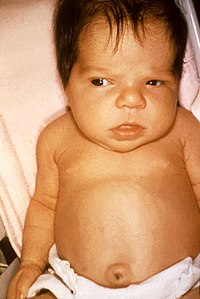
Photo from wikipedia
SummaryThis study attempts to discuss the correlation between UGT1A1*28 as uridine diphosphate glucuronosyltransferase gene promoter and coding region Gly71Arg gene polymorphism with neonatal hyperbilirubinemia of neonates in Wuhan. A total… Click to show full abstract
SummaryThis study attempts to discuss the correlation between UGT1A1*28 as uridine diphosphate glucuronosyltransferase gene promoter and coding region Gly71Arg gene polymorphism with neonatal hyperbilirubinemia of neonates in Wuhan. A total of 168 neonates were divided into the hyperbilirubinemia group (case group, n=108) and healthy neonates group (control group, n=60). Their DNA was obtained through blood extraction. The gene exon mutation of UGT1A1 was detected by Sanger sequencing, which revealed the relationship between UGT1A1*28 and Gly71Arg polymorphism with neonatal hyperbilirubinemia of neonates. The results showed that: (1) The frequency of UGT1A1*28 allele mutation in the case group and the control group was 9.3% and 10% respectively, with the difference being not significant between the two groups (P>0.05). (2) The frequency of Gly71Arg allele mutation in the case group and the control group was 35.1% and 21.7% respectively, with the difference being significant between the two groups (P<0.01). (3) The serum bilirubin level of Gly71Arg mutant homozygous and heterozygous subgroups (n=66) in the case group was 302.7±31.4 μmol/L, which was significantly higher than 267.3±28.5 μmol/L of the wild subgroup (n=42) (P<0.01). It was suggested that the occurrence of neonatal hyperbilirubinemia of neonates in Wuhan was not associated with UGT1A1*28 gene polymorphism, but closely with the Gly71Arg gene polymorphism. Meanwhile, the Arg allele mutation was related to the degree of jaundice.
Journal Title: Current Medical Science
Year Published: 2017
Link to full text (if available)
Share on Social Media: Sign Up to like & get
recommendations!